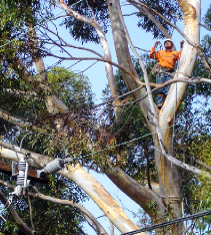

The safety of our customers, communities, and employees is our No. 1 priority. State regulations require utilities to trim trees or vegetation so they don’t grow into or fall into high-voltage power lines, which could not only cause a power outage but could spark a fire or be a danger to the public.
SCE inspects approximately 900,000 trees annually, including 400,000 trees in High Fire Risk Areas, and prunes nearly 700,000 trees annually.
In High Fire Risk Areas, SCE will trim or remove trees to maintain a minimum 12-foot clearance (at the time of trim) from power lines to prevent vegetation from coming into contact with electrical equipment and potentially sparking a fire. Tall trees up to 200 feet from high-voltage wires will be assessed to determine if they could fall into or have vegetation like palm fronds that could blow into power lines.
Trees that overhang wires, have weak branches, or are dead, diseased, or dying may be removed if they risk falling into the lines.
What are the rules for trimming trees?
Regulations (CPUC GO 95, Rule 35, and CA PRC 4292 and 4293) require utilities to trim trees or vegetation so they don’t grow into or fall into high-voltage power lines, which could not only cause a power outage but could spark a fire or be a danger to the public.
What does SCE consider when pruning a tree?
SCE considers the potential risk of the tree contacting energized utility power lines. Trees are trimmed or pruned to protect public safety and safeguard the reliability of electric equipment. They are trimmed in accordance with national standards designed to protect tree health. The pruning focuses on line clearance and does not necessarily consider aesthetics.
Why are some trees cut back so drastically?
In some cases, the tree’s size, location, and structure may leave SCE with no choice but to remove a significant amount of its foliage to protect the safety of the customer and their property and meet the state clearance requirements.
Why does SCE top trees?
SCE follows utility best practices when it trims trees for public safety. When a tree grows directly under a power line, and there are no pruning alternatives, SCE will top the tree to create a safety zone between the tree and the power lines. In these cases, SCE advises removal of the tree and will recommend a replacement from its “right tree, right place” brochure.
Does SCE use arborists? What is their role?
SCE’s vegetation management personnel responsible for overseeing field operations are arborists certified by the International Society of Arboriculture. SCE’s vegetation contractors also have experienced utility arborists, who are supervised by certified arborists.
What’s the responsibility of the public and our customers?
Safety is everyone’s responsibility. Customers must plan their landscape, plant trees and vegetation responsibly, and consider whether they will grow into power lines. SCE’s “Right Tree, Right Place” brochure provides some guidance on making landscape decisions. If you see a tree or vegetation that could be hazardous, don’t hesitate to contact SCE’s customer support at 1-800-611-1911 or visit sce.com/safety.
Can I have my own tree trimmer prune my tree?
Only specially trained tree trimmers can work near power lines. Homeowners who hire their own tree trimmers to Prune or remove trees near wires must first notify SCE. This includes work on any tree within 10 feet of SCE lines or trees that could come in contact with wires or equipment if they fall.
SCE offers a free “make-safe” program. As part of this program, SCE will assess and remove portions of trees to a level that would allow other workers to remove or prune the rest of the tree safely. For all inquiries, don't hesitate to contact customer support at 1-800-611-1911 or sce.com/safety.
How will I know if SCE is going to trim my trees?
After SCE completes its tree inspections, we will attempt to notify customers via door hangers at least 30 days Before any work. We will attempt to notify customers again with a second door hanger 24-48 hours before trimming any tree(s). The door hanger contains contact information for the tree inspector should you have any questions or concerns.
What is SCE’s authority to access property?
Under new California laws, after giving homeowners in High Fire Risk Areas notice and an opportunity to be heard, SCE has the authority to access private property and prune or remove vegetation as needed to ensure public safety and maintain reliable electrical service. Our foremost priority is to protect customers, their property and the public.
What happens when you must remove a tree?
SCE or an approved contractor will attempt to talk to the property owner to explain the tree removal process. SCE or an approved contractor will cut down the tree at no charge to the customer. The crew will dispose of the tree.
Will I have to pay for SCE’s tree trimming or removal?
No. All tree trimming is done as part of SCE’s annual vegetation management work at no additional cost to the customer.
Contact Us
If you have questions about SCE’s vegetation management activities or any concerns about trees near SCE power lines, email SCE customer support at safetrees@sce.com.

